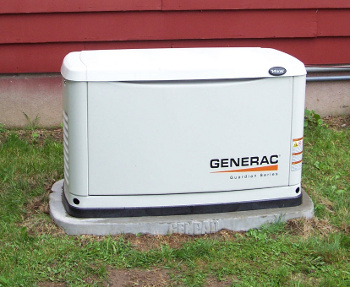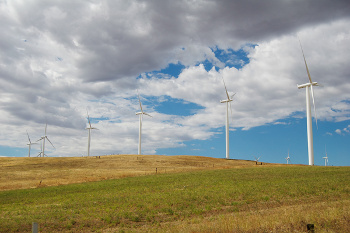
The Electrical Grid
September 30, 2013 The Big Yellow Taxi is a 1970 song by Canadian folk singer, Joni Mitchell. The lyrics have the following memorable lines,Don't it always seem to goThis sentiment seems to be more and more applicable to electrical power supply in the US and elsewhere. In my own experience, power outages of a few minutes or hours have suddenly morphed into week-long outages. Seeing a trend, my wife and I bought a natural gas electrical generator, as shown in the photo.
That you don't know what you've got
Till it's gone.
 | Fourteen kilowatts of peace of mind. This natural gas electrical generator powers our house when the utility supply fails. The switch-over occurs automatically after ten seconds. (Photo by author.) |
Recent studies show that in interdependent networks a very small failure in one network may lead to catastrophic consequences. Above a critical fraction of interdependent nodes, even a single node failure can invoke cascading failures that may abruptly fragment the system, while below this "critical dependency" (CD) a failure of few nodes leads only to small damage to the system.A randomly structured network will degrade slowly when nodes are removed, so there will be time to fix the network problem and belay a system collapse. An orderly lattice network, however, has critical nodes; and, since no one wants to put additional components into a working network, such networks always operate near a critical instability.[4] Shlomo Havlin, a professor of physics at Bar Ilan University and an author of the study, says that the 2003 blackout is an example of this type of network instability.[4] Others think that the ideal systems analyzed by Havlin and his colleagues might not always extrapolate to the real world. Jeffrey Dagle is an electrical engineer at the Pacific Northwest National Laboratory (Richland, Washington), and he served on the investigating committee for the 2003 blackout. Dagle is quoted in Nature News as saying, "The problem is that this doesn't reflect the physics of how the power grid operates.[4] Havlin's recommendation, based on his network theory, is that a small number of transmission lines should be added to join certain nodes on the grid to offer alternative paths. That would be expensive, and some think it won't really work.[4] Transmission is only part of problem of getting reliable electricity into my home. The other part is supply, and the world has been working towards the use of more renewable energy sources. Since many renewable energy sources, such as solar and wind, are intermittent, there's a need to store energy when it's in excess for use at other times. I wrote about energy storage in a recent article, Compressed Air Energy Storage, July 24, 2013. A recent study by Stanford University scientists with the Global Climate and Energy Project and the Department of Energy Resources Engineering has looked at the energy storage problem from the perspective of energy returned on energy invested as it applies to solar and wind systems.[6-8] Surprisingly, it might be better for the environment to temporarily shut down a wind turbine than to store its surplus energy.[7]
 | It might be better for the environment to temporarily shut down a wind turbine than to invest in an electrical storage system. (Stanford University photograph by Charles Barnhart.)[7] |
"You wouldn't spend $100 on a safe to store a $10 watch... Likewise, it's not sensible to build energetically expensive batteries for an energetically cheap resource like wind, but it does make sense for photovoltaic systems, which require lots of energy to produce."[7]One simple way of increasing the energy return on investment for batteries is by extending their working life. Batteries for grid energy storage should endure 10,000 to 18,000 charge-discharge cycles.[7] One technology that has the greatest energy return on investment is pumped hydroelectric storage in which water is pumped uphill. The energy return on investment for pumped hydroelectric storage is ten times better than for conventional batteries.[7] Compressed air energy storage, which I wrote about in a recent article (Compressed Air Energy Storage, July 24, 2013), has an energy return on investment similar to pumped hydroelectric storage.
References:
- Allan Sniffen, Musicradio 77 WABC-The Greatest Top Forty Music Radio Station of All Time!.
- Amir Bashan, Yehiel Berezin, Sergey V. Buldyrev and Shlomo Havlin, "The extreme vulnerability of interdependent spatially embedded networks," Nature Physics (advance online publication, 2013), doi:10.1038/nphys2727.
- Amir Bashan, Yehiel Berezin, Sergey V. Buldyrev and Shlomo Havlin, "The extreme vulnerability of interdependent spatially embedded networks," arXiv Preprint Server, June 9, 2013.
- Jeff Tollefson, "US electrical grid on the edge of failure," Nature News, August 25, 2013.
- Dong Zhou, Amir Bashan, Yehiel Berezin, Reuven Cohen and Shlomo Havlin, "On the Dynamics of Cascading Failures in Interdependent Networks," arXiv Preprint Server, November 10, 2012.
- Charles J. Barnhart, Michael Dale, Adam R. Brandt and Sally M. Benson, "The energetic implications of curtailing versus storing solar- and wind-generated electricity," Energy Environ. Sci., (Advance Article, 2013), DOI: 10.1039/C3EE41973H.
- Mark Shwartz, "Stanford scientists calculate the energy required to store wind and solar power on the grid," Stanford University Press Release, September 9, 2013.
- Stanford University Global Climate and Energy Project Web Site.
- Amir Bashan, Yehiel Berezin, Sergey V. Buldyrev and Shlomo Havlin, "The extreme vulnerability of interdependent spatially embedded networks," Nature Physics (advance online publication, 2013), doi:10.1038/nphys2727.